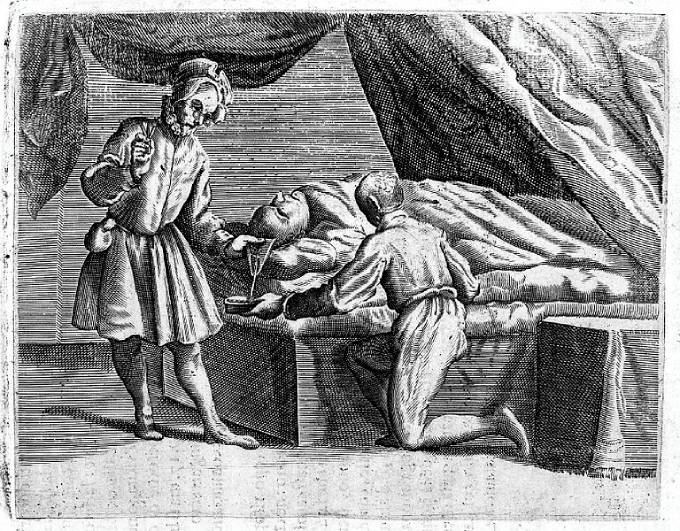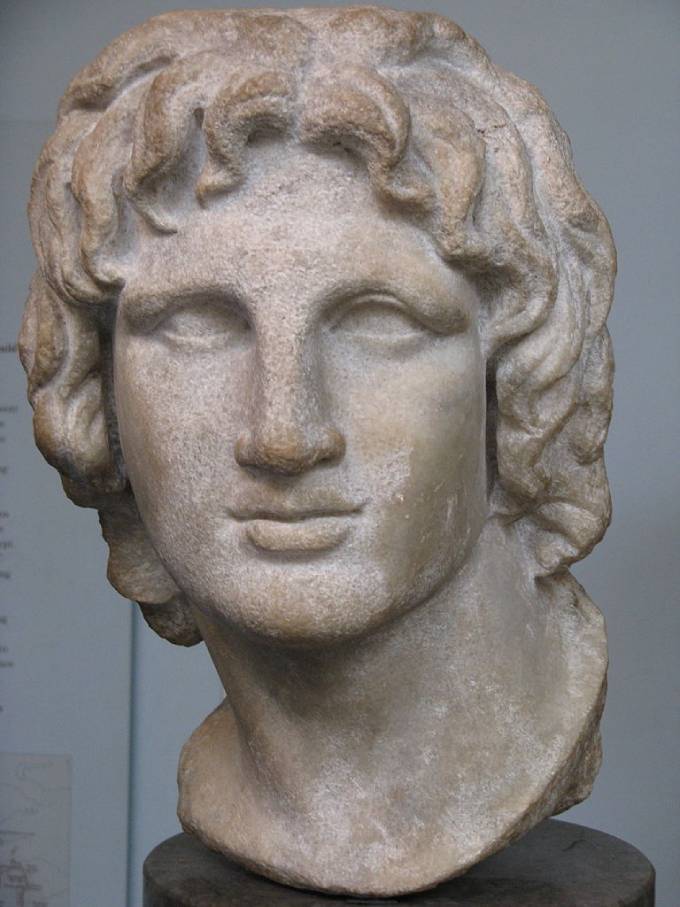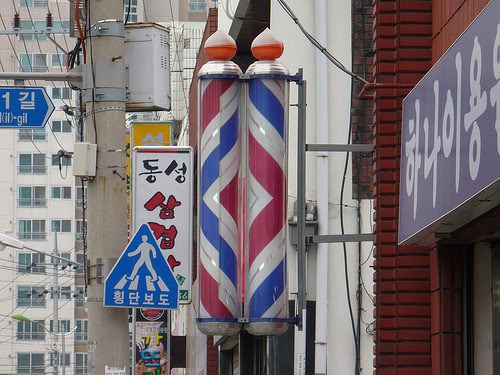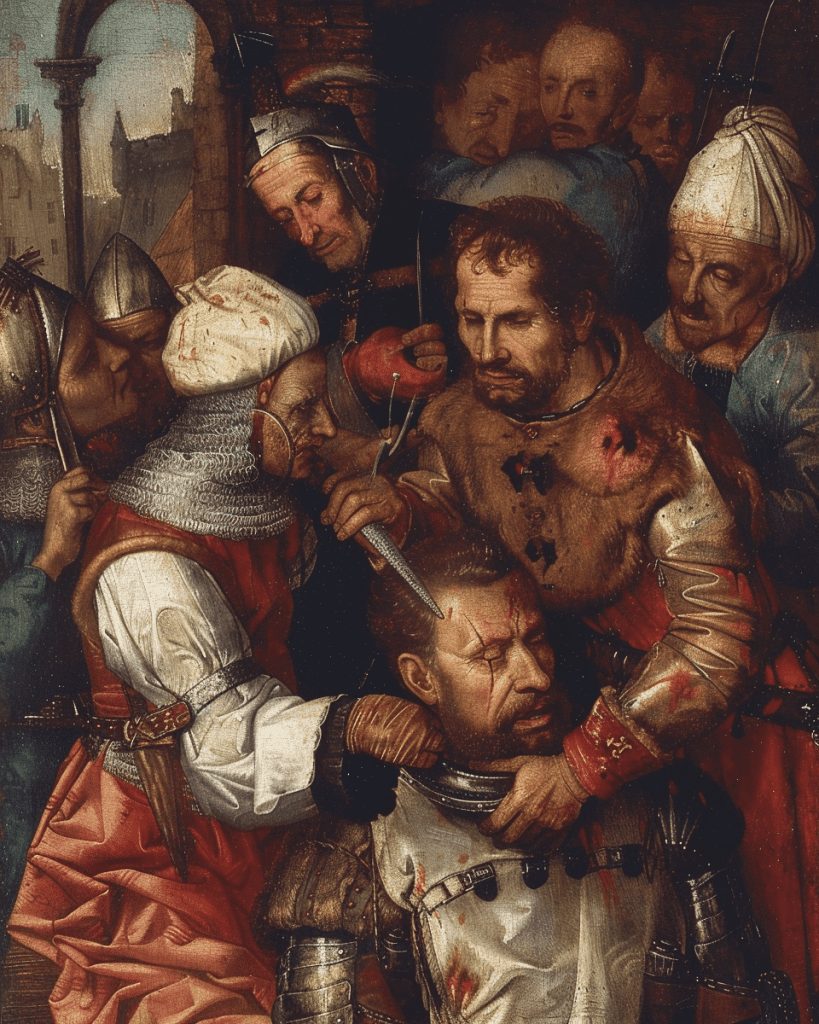Why are the poles outside barber shops red, white and blue in the USA? Why do they have red and white stripes in many other countries? And why do they rotate in a spiral?
The classic barber’s pole with its distinctive appearance is a recognized symbol of the barber shop used in many countries. But its history is rather gruesome. It wasn’t just a haircut that people got at the barbershop in times gone by.
Barber-surgeons
Barbers didn’t just deal with male grooming back in the middle ages. Known as barber-surgeons, their services went far further than that. They performed necessary surgery, such as amputation. They also extracted teeth, gave enemas, and carried out bloodletting.

to cure a broken heart. (Image: Wikimedia/Wellcome Trust)
The bandages used to stem the blood flow from bloodletting were white but became stained with blood. After washing them, barbers would hang these bandages on a post outside the shop to dry. The fluttering red and white bandages became an advertisement for their trade and the origin of the rotating striped barber pole.
When the bandages evolved into more formal signage, a pole was used to signify the original pole that people would clutch in their fists to make their veins stand out and enable the bloodletting. At the top of the pole, a bowl was placed that held leeches. At the bottom, a basin was attached like those used to catch the blood.
In London, barber-surgeons advertised their trade using an actual bowl containing blood outside the shop, but this was eventually banned for hygiene reasons.
History of the barber-surgeon
So how did this come about? How did these two professions, these days thankfully completely separate, end up being done by the same people?
Barbering as a trade has a long history. Barbering goes back to the Bronze Age, is mentioned in the bible, and existed in ancient Egypt. The word barber comes from the Latin Barba, meaning beard. Alexander the Great was a great believer in the virtues of being clean-shaven as he felt it gave his soldiers an advantage on the battlefield. A bearded soldier could be grabbed by the beard and overpowered in close combat, but not the clean-shaven. Only free men were allowed to shave in ancient Rome, and slaves were recognized by their beards. So barbering was important from a status point of view.

Barbers needed sharp implements to cut and shave, and these evolved into razors. Surgeons also required sharp knives.
Surgery was extremely basic at the time and primarily consisted of simply removing a wounded or diseased body part. It was often needed by soldiers injured on the battlefield. Physicians routinely looked down on this kind of work and repeatedly refused to carry it out. Having the tools of the trade to hand, barbers could step in.
Bloodletting was another unfortunate practice in medieval medicine, and here again, barbers had a role to play.
Medieval methods
In the middle ages, some illnesses were considered to be caused by too much blood in certain parts of the body. Bloodletting, where a vein was cut, and the blood drained out, was used to treat various ailments from sore throats to the plague. Leeches placed on a patient’s skin were also thought to help by depriving them of their excess blood.
Once again, physicians considered themselves above these kinds of treatments. Monks used to perform bloodletting for sick people, but in 1163 Pope Alexander III ordered all monks to stop the bloodletting. Barbers ended up taking on the job and numerous other simple medical procedures such as bone-setting, amputation, enemas, and pulling teeth.
So a trip to the barber in the Middle Ages would have been much more varied – and possibly painful – than a trip for a haircut today.
Barber-surgeons of France
The first organization of barber-surgeons in France was formed as early as 1094. The College de Saint-Come et Saint-Damien in Paris, back in the thirteenth century, distinguished between academic surgeons and barber-surgeons by the length of their robes. Academic surgeons were described as surgeons of the long robe, and barber-surgeons were surgeons of the short robe. This reflected an important social distinction.
Nevertheless, the social standing of barber-surgeons did improve. A guild of barber-surgeons was formed in 1391, and the profession was admitted to the University of Paris in 1505.
Ambroise Pare, considered the father of modern surgery, started life as a barber-surgeon. Pare practiced in the sixteenth century and served four successive French kings. But he and his family all had humble origins; his brother and brother-in-law were also barber-surgeons.

A bloody trade in England
In England, the two professions of barber and surgeon were separated in the fifteenth and sixteenth centuries, but they remained linked. The Company of Barbers was formed in 1462. Surgeons had a separate guild, but they were brought together in 1540 in the United Barber Surgeon’s Company. However, barbers were not allowed to perform any surgery except bloodletting and tooth extraction by this time. Surgeons, for their part, were banned from the “barbary of shaving.”
This distinction was also made visible. Barbers had to use a blue and white pole while surgeons used a red pole.
Addition of blue
So why is the barber pole in America red, white, and blue but only red and white in many other countries?
Blue was also used to denote a barber in some places, particularly once the two trades of barber and surgeon became separated. In Amsterdam in Renaissance times, red was used for surgery and blood services, white for bones and teeth, and blue for a barber. In England, blue and white could also mean a barber.
However, other records suggest that when barbers were separated from the profession of doctor/surgeon, the latter used blue to represent them.
So the US version of the barber pole could simply combine these three elements. It may also have started up out of patriotism and a desire to show the colors of the American flag.
Another theory is that red could signify arteries and blue veins, while white depicts the bandages. Perhaps we will never know for sure, but the ideas are certainly colorful.
Use with caution
In the USA, there is some controversy over using the classic barber pole. In some states, barbering requires a license, while hairdressing does not. The pole is for a licensed barber only, so you can’t just put one up outside any old hair salon. Lawsuits have started up about the use of barber poles by establishments that might not be bona fide barbers. So the pole is a prized symbol of an ancient trade.
Other meanings
A word of warning when traveling abroad; in some countries, such as South Korea and Taiwan, a red and white striped pole can also signify a brothel.

Common term
The barber pole is now established in English language usage and is often used to describe something with spiral features that moves or rotates. From candy to computer screens, fishing to space travel, parachuting to electronics, the term ‘barber pole’ is widely used to describe something resembling those familiar spiraling stripes.

